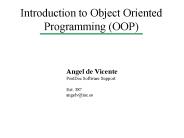Programming by Delegation - PowerPoint PPT Presentation
1 / 19
Title:
Programming by Delegation
Description:
Barring errors, this generates Area.class. E. C. Launch an ... Barring errors, this generates Area.class. Post-Compilation Errors. Post-Compilation Errors ... – PowerPoint PPT presentation
Number of Views:33
Avg rating:3.0/5.0
Title: Programming by Delegation
1
Chapter 2
Programming by Delegation
2
Outline
2.1 Computing Paradigms 2.1.1 Procedural
Paradigm 2.1.2 Modular Paradigm 2.1.3 Object-Ori
ented Paradigm 2.1.4 Case Study Procuring
Bread 2.2 Application Development 2.2.1 Applicat
ion Architecture 2.2.2 The Client
View 2.2.3 Post-Compilation Errors 2.2.4 Case
Study The Java Standard Library
3
2.1 Computing Paradigms
import java.lang.System public class Area
public static void main(String args)
int width 8 int height 3 int
area width height System.out.println(a
rea)
The code inside the rectangle computes the area
of a circle. It handles both storage (of data)
and computation (of area). Let us explore
delegating one or both of these tasks.
4
2.1.1 Procedural Paradigm
Keep storage but delegate computation to a class
int width 8 int height 3 int area
Rectangle1.computeArea(width, height)
- A method belongs to a class. It performs an
action, and hence, its name is a verb
(computeArea) or a complete predicate
(isEnabled). - The method name must be followed by a pair of
parenthesis with any parameters needed sandwiched
in between. - The method name together with the types of its
parameters make up the method signature. It is
unique per class. - The method's action culminates in a return. It
can be void. - Invocation syntax class_name.method(). It is
like dialing the phone number of a company
followed by someone's extension.
5
2.1.2 Modular Paradigm
Delegate both storage and computation to a class
Rectangle2.width 8 Rectangle2.height
3 int area Rectangle2.getArea()
- An attribute belongs to a class. It holds data,
and hence, its name is a noun (width). It has a
type. - Java treats attributes like variables except you
do not declare them in your program (their class
takes care of that) and the notion of scope does
not apply to them. - The attribute name is unique per class.
- Access syntax class_name.attribute.
- Because the class name appears before the dot, we
say that you invoke a method, or access an
attribute, on the class.
6
UML (Unified Modeling Language)
The class diagram of a procedural class
The class diagrams of two modular classes
7
2.1.3 Object-Oriented Paradigm
Delegate both to an instance of a class
Rectangle3 r new Rectangle3() r.width
8 r.height 3 int area r.getArea()
- Create an instance (a.k.a object) of a class that
can handle storage and computation and work with
the instance as if it is a module. - The instance has a name, r, known as the object
reference. - The attributes are accessed, and the methods are
invoked, on the instance, not on the class. - Think of the object (or instance) as a copy of
the original class. - Each object can store different values in its
attributes these values are known as the state
of the object.
8
UML (Non-Utility Classes)
The class diagram of an object oriented class
along with the object diagrams of two instances
of it
The class diagrams of an object-oriented class in
the Java standard library
9
2.2.1 Application Architecture
- A Java application consists of several
cooperating classes. One of the classes starts
the application, and is known as the main class.
The other classes are known as helpers or
components. - The main class for a desktop application (as
opposed to an applet or servlet) is known as an
app. It must have a method with the following
header
public static void main(String args)
- The main class delegates to components. And as
more ready-made components become available,
application development will reduce to developing
the main class.
10
2.2.2 The Client View
- The client is the developer of the main class.
The implementer is the developer of a component. - The client understands the big picture, the
purpose of the application. The implementer
focuses only on the inner details of one
component. - The client knows how to shop for components and
how to read their specs i.e. knows what each one
does but not how it does it. - This course focuses on being a client. It
prepares you to write applications using
components that are already available. - Separation of concerns means the client and the
implementer share info on a need-to-know basis.
11
The Client View
- Given a component, the client does not care what
is inside it, only what it does. This is known as
its interface or API (application programming
interface). - The class of a component thus encapsulates it. An
attempt to look inside is breaking the
encapsulation.
12
The Client View
A class is made up of features. A feature is an
attribute or a method. The class of a component
classifies each feature as either public or
private depending, respectively, on whether the
client needs or does not need to know about it.
The API (interface) of a component lists only
the headers of its public methods and the
declarations of its public attributes (a.k.a.
fields).
13
2.2.3 Post-Compilation Errors
- Launch an editor and write the program
- Save it as Area.java
E
14
Post-Compilation Errors
- Launch an editor and write the program
- Save it as Area.java
E
- Launch a console
- Compile by issuing javac Area.java
- Barring errors, this generates Area.class
C
15
Post-Compilation Errors
- Launch an editor and write the program
- Save it as Area.java
E
- Launch a console
- Compile by issuing javac Area.java
- Barring errors, this generates Area.class
C
- Run Area.class by issuing java Area
- Enjoy!
R
16
(No Transcript)
17
Post-Compilation Errors
18
2.2.4 Case Study the JDK
Directory structure
19
Case Study the JDK
Top-level packages































